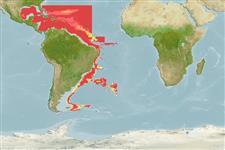Environment: milieu / climate zone / depth range / distribution range
Ökologie
seewasser bathypelagisch; tiefenbereich 320 - 1100 m (Ref. 51655). Deep-water; 30°N - 0°
Western Atlantic: Florida, USA to northern Brazil, including the Gulf of Mexico, the Bahamas and the Greater Antilles.
Length at first maturity / Size / Gewicht / Alter
Maturity: Lm ?, range 8 - ? cm
Max length : 9.2 cm SL Männchen/unbestimmt; (Ref. 37039)
Rückenflossenstacheln (insgesamt) : 5 - 7; Rückenflossenweichstrahlen (insgesamt) : 8 - 15; Afterflossenstacheln: 3 - 5; Afterflossenweichstrahlen: 7 - 9; Wirbelzahl: 28 - 29. Side of body covered with deciduous small cycloid scales (Ref. 13608).
Kasidoron, once given family status as Kasidoridae, is the larva of this species (Ref. 6993). Adults found at depths of 320 - 1,100 meters and larvae at 0 - 50 meters (Ref. 51655). Feeds on amphipods and copepods (Ref. 37039).
Life cycle and mating behavior
Geschlechtsreife | Fortpflanzung | Ablaichen | Eier | Fecundity | Larven
McEachran, J.D. and J.D. Fechhelm, 1998. Fishes of the Gulf of Mexico. Volume 1: Myxiniformes to Gasterosteiformes. University of Texas Press, Austin. 1112p. (Ref. 37039)
IUCN Rote Liste Status (Ref. 130435: Version 2024-2)
Bedrohung für Menschen
Harmless
Nutzung durch Menschen
Fischereien: nicht kommerziell
Tools
Zusatzinformationen
Download XML
Internet Quellen
Estimates based on models
Preferred temperature (Ref.
123201): 7.1 - 11.8, mean 9.4 °C (based on 83 cells).
Phylogenetic diversity index (Ref.
82804): PD
50 = 1.0000 [Uniqueness, from 0.5 = low to 2.0 = high].
Bayesian length-weight: a=0.01122 (0.00514 - 0.02450), b=3.04 (2.87 - 3.21), in cm total length, based on all LWR estimates for this body shape (Ref.
93245).
Trophic level (Ref.
69278): 3.1 ±0.35 se; based on food items.
Fishing Vulnerability (Ref.
59153): Low vulnerability (10 of 100).
